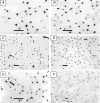Vascular endothelial growth factor mRNA and protein do not change in parallel during non-inflammatory skeletal muscle ischaemia in rat
- PMID: 16990404
- PMCID: PMC1890445
- DOI: 10.1113/jphysiol.2006.113357
Vascular endothelial growth factor mRNA and protein do not change in parallel during non-inflammatory skeletal muscle ischaemia in rat
Abstract
Impaired blood flow is thought to induce a pro-angiogenic environment due to local hypoxia, yet prolonged mild ischaemia induces only modest capillary growth. We compared the expression of vascular endothelial growth factor (VEGF) mRNA and protein with capillary to fibre ratio (C: F) and muscle blood flow in extensor digitorum longus of rats that had undergone unilateral ligation of the common iliac artery. Resting blood flow during the first two weeks after ligation (3, 7 and 14 days) was decreased by approximately 60% but recovered partially after 5 weeks (36% reduction). Functional hyperaemia (9-fold increase in blood flow during contractions) was eliminated in the first week after ligation, with a moderate recovery seen after 14 and 35 days. Muscle histology confirmed the absence of tissue necrosis or inflammation. Both VEGF mRNA (60%, P<0.05) and protein levels (700%, P<0.01) increased during the initial phase of ischaemia (at 1 and 3 days), well before any overt angiogenesis, and both declined towards control levels by 7 days. A secondary increase in VEGF protein (by 60% at 14 days, P<0.05) preceded the 20% increase in C: F seen after 5 weeks, but occurred while VEGF transcript levels continued to decline (to 50% of control at 35 days, P<0.05). Thus, evaluation of neither VEGF mRNA nor protein is an adequate index of angiogenic potential in response to ischaemia. We conclude that VEGF alone is insufficient to induce angiogenesis in ischaemic conditions, and that effective angiotherapy requires intervention aimed at other cytokines.
Figures





Similar articles
-
Differential expression of Flk-1 and Flt-1 in rat skeletal muscle in response to chronic ischaemia: favourable effect of muscle activity.Clin Sci (Lond). 2003 Oct;105(4):473-82. doi: 10.1042/CS20030035. Clin Sci (Lond). 2003. PMID: 12780346
-
Activation of fractalkine/CX3CR1 by vascular endothelial cells induces angiogenesis through VEGF-A/KDR and reverses hindlimb ischaemia.Cardiovasc Res. 2008 May 1;78(2):333-40. doi: 10.1093/cvr/cvm067. Epub 2007 Nov 11. Cardiovasc Res. 2008. PMID: 18006432
-
HIF-1alpha and HIF-2alpha play a central role in stretch-induced but not shear-stress-induced angiogenesis in rat skeletal muscle.J Physiol. 2007 Sep 1;583(Pt 2):753-66. doi: 10.1113/jphysiol.2007.136325. Epub 2007 Jul 12. J Physiol. 2007. PMID: 17627993 Free PMC article.
-
Adaptation of skeletal muscle microvasculature to increased or decreased blood flow: role of shear stress, nitric oxide and vascular endothelial growth factor.J Vasc Res. 2009;46(5):504-12. doi: 10.1159/000226127. Epub 2009 Jun 26. J Vasc Res. 2009. PMID: 19556804 Review.
-
Gene transfer for therapeutic vascular growth in myocardial and peripheral ischemia.Adv Genet. 2004;52:117-64. doi: 10.1016/S0065-2660(04)52004-7. Adv Genet. 2004. PMID: 15522734 Review.
Cited by
-
Therapeutic assessment of mesenchymal stem cells delivered within a PEGylated fibrin gel following an ischemic injury.Biomaterials. 2016 Sep;102:9-19. doi: 10.1016/j.biomaterials.2016.06.011. Epub 2016 Jun 7. Biomaterials. 2016. PMID: 27318932 Free PMC article.
-
Shear stress-induced angiogenesis in mouse muscle is independent of the vasodilator mechanism and quickly reversible.Acta Physiol (Oxf). 2016 Nov;218(3):153-166. doi: 10.1111/apha.12728. Epub 2016 Jul 1. Acta Physiol (Oxf). 2016. PMID: 27261201 Free PMC article.
-
Angio-adaptation in unloaded skeletal muscle: new insights into an early and muscle type-specific dynamic process.J Physiol. 2010 Nov 15;588(Pt 22):4579-91. doi: 10.1113/jphysiol.2010.193243. Epub 2010 Sep 27. J Physiol. 2010. PMID: 20876198 Free PMC article.
-
Attenuation of changes in capillary fine structure and leukocyte adhesion improves muscle performance following chronic ischaemia in rats.J Physiol. 2008 Oct 15;586(20):4961-75. doi: 10.1113/jphysiol.2008.158055. Epub 2008 Aug 28. J Physiol. 2008. PMID: 18755748 Free PMC article.
-
The chemokine system in arteriogenesis and hind limb ischemia.J Vasc Surg. 2007 Jun;45 Suppl A(Suppl A):A48-56. doi: 10.1016/j.jvs.2007.02.030. J Vasc Surg. 2007. PMID: 17544024 Free PMC article. Review.
References
-
- Anderson SI, Hudlicka O, Brown MD. Capillary red blood cell flow and activation of white blood cells in chronic muscle ischemia in the rat. Am J Physiol. 1997;272:H2757–H2764. - PubMed
-
- Askew CD, Green S, Walker PJ, Kerr GK, Green AA, Williams AD, Febbraio MA. Skeletal muscle phenotype is associated with exercise tolerance in patients with peripheral arterial disease. J Vasc Surg. 2005;41:802–807. - PubMed
-
- Baum O, Djonov V, Ganster M, Widmer M, Baumgartner I. Arteriolarization of capillaries and FGF-2 upregulation in skeletal muscles of patients with chronic peripheral arterial disease. Microcirculation. 2005;12:527–537. - PubMed
-
- Brown MD, Kent J, Kelsall CJ, Milkiewicz M, Hudlicka O. Remodeling in the microcirculation of rat skeletal muscle during chronic ischemia. Microcirculation. 2003;10:179–191. - PubMed
-
- Brown MD, Verhaeg J, Milkiewicz M, Lamont P, Stewart A. Capillarity and vascular endothelial growth factor in calf biopsies from patients with intermittent claudication after a supervised exercise programme. J Vasc Res. 2002;39(Suppl. 1):45. abstract.
Publication types
MeSH terms
Substances
LinkOut - more resources
Full Text Sources
Other Literature Sources

